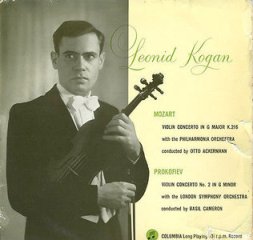The Art Of Leonid Kogan (2014) CD4 - Mozart: Violin Concerto No.3 - Prokofiev: Violin Concerto No.2
The Art Of Leonid Kogan (2014) CD4 - Mozart: Violin Concerto No.3 - Prokofiev: Violin Concerto No.2

Mozart: Violin Concerto No.3 in G major K.216 1. I. Allegro (8:30) 2. II. Adagio (8:01) 3. III. Rondo: Allegro (6:23) Leonid Kogan - violin Philharmonia Orchestra Otto Ackermann – conductor Prokofiev: Violin Concerto No.2 in G minor op.63 4. I. Allegro moderato (9:30) 5. II. Andante assai (8:40) 6. III. Allegro, ben marcato (6:25) Leonid Kogan - violin London Symphony Orchestra Basil Cameron - conductor
The G Major Concerto, dating from September 12, 1775, was first performed in Salzburg shortly after that date, most probably with Mozart himself as soloist. The work opens with an orchestral presentation of a theme that Mozart had devised a few months earlier for use in his comic opera Il rè pastore, which was composed to honour a visiting dignitary; one of the composer's few cases of self-borrowing. The light but formal quality appropriate to such an occasion transposes well into the concerto environment, and the various themes and motifs presented by the soloist follow one another in such a natural order that the music flows along smoothly, while providing enormous variety in rhythm and orchestral colour. The oboes lend a special quality, sounding like ever-present commentators on the soloist’s ideas.
The slow movement is one of those ravishingly sensuous adagios that are a Mozart hallmark, and is the only movement in which the flutes participate. The single theme has two distinct sections, the first a long legato phrase, followed by a more detached passage. The movement is in the customary ternary form, but the middle section provides contrast by transformation of the theme in the minor mode.
The concluding Rondeau (Mozart specified this French term for his violin concerto finales) is a sequence of captivating vignettes, among them a beguiling little serenade by the soloist with pizzicato accompaniment from the orchestral strings, and a musette-like rendering of a popular tune before the proceedings come to a somewhat unexpected close in which the winds have the last gentle word; Mozart chose to end the concerto with the lonely oboe theme in G major played piano, giving the feeling of a musical ‘disappearing’. --- bhco.co.uk
The multicolored strands of influence -- personal and creative -- that converged on composer Sergei Prokofiev lent to his musical career a strange richness and duality. Prokofiev's musical development evolved in the constant shadow of multiple and often paradoxical circumstances. Raised and trained in the culture of waning imperial Russia, he would nonetheless emerge as one of the brightest stars in the Soviet Union's world of stringent artistic doctrines. Though hailed early on as a "bad boy" modernist, simplicity, urged by Soviet strictures, became Prokofiev's ultimate goal. Still, he steadfastly continued to employ those aspects -- novel and unexpected harmonic turns, melodic athleticism, and a prodigious handling of rhythm -- which from the outset marked the uniqueness of his style.
The aspects of change and multiplicity in Prokofiev's music, both within individual works and in the larger scope of his evolving style, are in no place more in evidence than in the Violin Concerto No. 2 in G minor, Op. 63 (1935). Indeed, the work took shape over the course of wide-ranging travels the composer undertook as part of his performing career. "Reflecting my nomadic concertizing existence," he wrote, "the Concerto was written in the most diverse countries: the main subject of the first movement was written in Paris, the first theme of the second movement -- in Voronezh, the instrumentation was completed in Baku, and the premiere took place in December of 1935 in Madrid." Undertaken (probably unbeknownst to the composer) as his final commission from a non-Soviet source, the Concerto already exhibits a particular attention to a less complicated -- though no less masterful -- handling of musical materials.
The first movement, Allegro moderato, opens with a plaintive, five-beat motive in the solo violin which, even at this early stage, creates a sense of metric imbalance from having been placed into a 4/4 meter. It is spun into a full-fledged melody in G minor which pushes onward, eventually punctuated by episodes of abrupt changes in tonality, rhythmic impulse, and mood. The built-up energy and perfunctory close of the first movement is rapidly dissipated by the arrival of the second, Andante assai, which is characterized by a wistful and perhaps nostalgic, unpretentious and songlike theme in E flat major. The orchestra provides a gentle, harmonically unobtrusive accompaniment as the violin's theme is varied and developed -- and later, gear-shiftingly interrupted -- in the course of the movement. The roles are reversed in the final bars as a thematic fragment and its pizzicato accompaniment, now provided by the solo violin, recapture the initial mood as they fade into quiet. The final movement, Allegro, ben marcato, emerges in triple-metered dance-like gestures, at times with the genteel reserve of a waltz, at others with a more rustic, uninhibited character. Episodes of grotesquerie and dark comedy spring forth and propel the movement forward toward its steely con brio, tumultuous close. ---Michael Rodman, Rovi
download (mp3 @320 kbs):
yandex 4shared mega mediafire zalivalka cloudmailru oboom uplea








